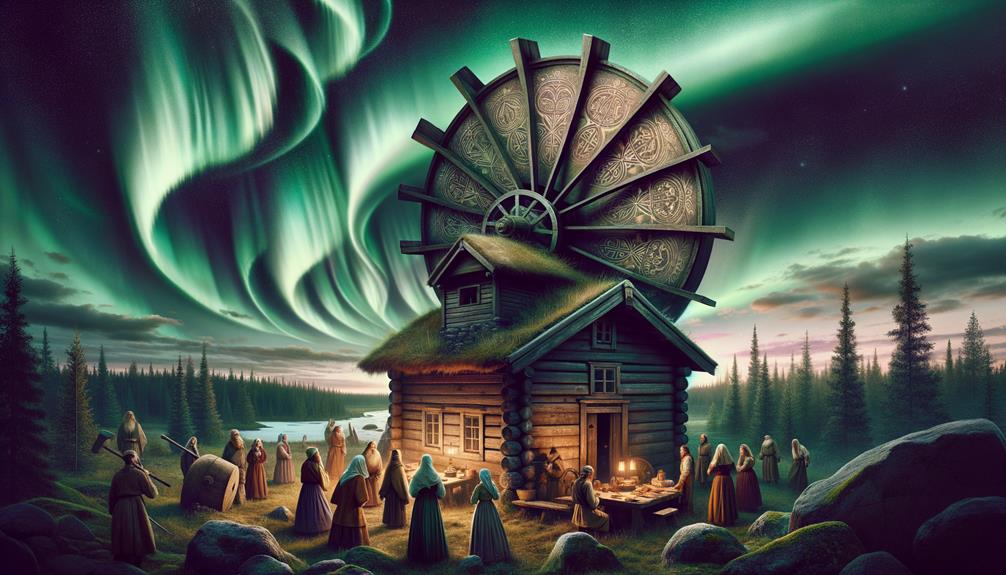In the age-old craft of metalsmithing, Ilmarinen’s skilled hands forged the extraordinary Sampo, a mill imbued with boundless magic and prosperity. This mythical creation, gifted to the goddess Louhi, didn’t merely produce salt, grain, and gold; it wove the very fabric of fortune itself. However, like all objects of immense power, the Sampo’s existence sparked conflict and desire, stolen and coveted, a symbol of cosmic balance and the eternal pursuit of abundance. How did this mill of dreams shape the fate of those who sought it? Let’s unravel the tale interwoven within the threads of the Kalevala.
Origins and Legends
The origins of the Sampo, a mythical creation, intertwine with ancient Finnish folklore. According to legends, the skilled blacksmith Ilmarinen crafted this enigmatic object for Louhi, a powerful goddess. Descriptions portray the Sampo as a prosperous mill, endlessly providing abundance. Its creation involved divine skill and elemental forces, underscoring the mythology’s interconnected cosmos.
However, the tale doesn’t conclude with Ilmarinen’s feat. Heroes like Väinämöinen sought to reclaim the Sampo, a quest reflecting the desire for cosmic balance. The Sampo’s eventual shattering scattered pieces believed to still hold immense power, solidifying its enduring legacy in Finnish mythology.
The narrative unfolds through straightforward storytelling, allowing the richness of Finnish folklore to captivate readers. The Sampo’s origins exemplify how mythological tales convey cultural values and beliefs through symbolism and allegory.
Symbolism and Themes

The Sampo mill, forged by the skilled blacksmith Ilmarinen in Finnish mythology, represents the cycles of nature and human prosperity. It produces salt, grain, and gold – essential elements for abundance and wealth. The mill’s rotating mechanism mirrors the cyclical nature of life, reflecting how fortune ebbs and flows.
When the Sampo is destroyed in myths, changes like salty seas and abundant hay growth signify the interconnectedness of all things. Here are key symbolic elements:
- Roots and branches depict how nature and human prosperity intertwine.
- Guardians highlight the mill’s immense power and the need to protect balance.
- The maiden figure embodies nurturing aspects of life and growth.
The Sampo mill symbolizes profound insights into the cycles of fortune and the importance of harmony. Its themes transcend mere mythology, revealing truths about the world.
Role in the Kalevala

The Kalevala, Finland’s national epic, centers around the creation and theft of the Sampo, a magical artifact forged by blacksmith Ilmarinen. The mill brought fortune to Pohjola, the land ruled by the powerful Louhi. With its roots, branches, and maiden figure, the Sampo represented life’s cyclical nature and humanity’s pursuit of prosperity.
Ilmarinen crafted the Sampo seeking peace and alliance with Louhi. However, the heroes’ envy over its riches sparked their scheme to steal it, upsetting the balance of power. Louhi retaliated fiercely to reclaim her treasured possession.
The Sampo saga encapsulates conflicts over wealth and authority. Its loss mirrored fortune’s impermanence and the perpetual cycle of gaining and losing. In Kalevala, the Sampo immortalized human ambition, resilience, and fate’s unpredictable dance.
Cultural Impact

The Sampo, symbolizing boundless prosperity and life’s eternal cycles, has profoundly shaped Finnish culture and mythology, echoing through generations as a representation of human aspirations and struggles. When forged, the Sampo embodied not only the creation of wealth but also the inherent challenges and power dynamics that come with it. This mythical mill, vividly brought to life in the Kalevala by Elias Lönnrot and translated by John Martin Crawford, encapsulates the cyclical nature of life and human endeavor.
The Sampo’s legendary tale has become woven into Finland’s cultural fabric, influencing countless generations. Its impact can be seen through representations of abundance in folklore, the emphasis on agriculture and life’s cycles, and the multitude of interpretations showcasing its enduring significance and adaptability.
The narrative, from forging to destruction, serves as an archetypal tale of creation, conflict, and renewal. Scholars like Anna-Leena Siikala have explored its symbolism deeply, revealing the profound ways this mythical artifact resonates within Finland’s cultural consciousness.
Modern Interpretations

In contemporary storytelling, the Sampo legend continues inspiring fresh tales, weaving ancient enchantment into modern narratives and creative works. Recent adaptations like the 1959 film ‘Sampo’ and the Finnish TV series ‘Rauta-aika’ breathe vibrant life into this timeless story. These retellings highlight the hero’s journey embedded within, where the quest for Sampo symbolizes the pursuit of prosperity and harmony.
Disney’s Don Rosa playfully introduces the Sampo to young readers in ‘The Quest for Kalevala.’ Meanwhile, bands like Amorphis and Amberian Dawn channel the myth’s archetypal energy into their music, crafting resonant songs steeped in mythic structure.
Beyond artistic realms, the Sampo’s cultural significance extends into science. Asteroid 2091 Sampo and a genus of fossil brachiopod bear its name, underscoring the myth’s enduring relevance.
| Medium | Modern Adaptations | Cultural Impact |
|---|---|---|
| Film & TV | ‘Sampo’ (1959), ‘Rauta-aika’ | Reimagining narratives |
| Comics | Disney’s ‘The Quest for Kalevala’ | Reaching new generations |
| Music | Amorphis, Amberian Dawn | Myth-inspired songs |
| Science | Asteroid 2091 Sampo, fossil genus | Scientific significance |
Aalto University’s Semantic Computing Group incorporates the Sampo legend into cultural heritage services, affirming its lasting impact in our digital era.
Frequently Asked Questions
What Is the Myth of the Sampo?
I dove into the myths of Finland, uncovering the Sampo—a mystical mill forged by Ilmarinen. This mill brought prosperity and abundance, but its theft and destruction led to chaos. In Finnish folklore, the Sampo symbolizes the disruption and restoration of cosmic balance.
What Does Sampo Mean in Finnish?
Sampo represents the cycle of creativity and continuity woven into Finnish culture. Academics interpret it as a sacred source of sustenance, a symbol of strength and spiritual success, shining through stories.
What Is the Mythical Weapon Sampo?
The mythical Sampo isn’t a conventional weapon. It’s an enchanted mill representing prosperity and abundance – the ultimate prize in my quest, symbolizing creation’s struggle against chaos. While powerful, the Sampo’s true might lies in its symbolic nature rather than any physical form.
What Is the History of Sampo?
Ancient Finnish folklore recounts the wondrous tale of Sampo, a mystical mill crafted by the legendary smith Ilmarinen. This artifact held immense power, bringing wealth and harmony to the land. However, its eventual shattering forever reshaped the world’s destiny.
The saga of Sampo unfolds through epic quests undertaken by mythical heroes. Its creation sparked conflicts and adventures, weaving a narrative that has captivated generations. The mill’s allure extended beyond its material worth, representing balance, abundance, and the enduring human pursuit of prosperity.
While the object’s true nature remains open to interpretation, its impact echoes through Finland’s cultural heritage. Sampo’s story continues to inspire artistic expression and scholarly analysis, affirming the lasting influence of ancient myths in contemporary society.


